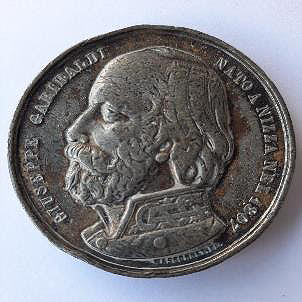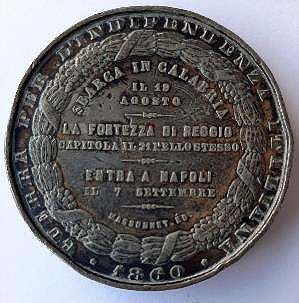The piece of the month of April 2020
COMMEMORATIVE MEDAL OF THE CONQUEST OF NAPLES (1860)
Eduardo Morales Solchaga
Chair of Navarrese Heritage and Art
It is 160 years since the disappearance of the Kingdom of the Two Sicilies and its incorporation into the Kingdom of Italy. This marked the culmination of the second phase of Italian unification, begun in 1859 and substantially carried out by the troops commanded by Giuseppe Garibaldi. His famous "Expedition of the Thousand", in a clearly inferior condition, consecutively annexed the territories of Naples and Sicily, until then under the tyranny of Francis II of Bourbon Two Sicilies. The figure of Garibaldi has always aroused the curiosity of his own and others, since his nineteenth century revolutionary and resilient personality took him away from Italy on many occasions. Uruguay, Peru, Tangiers or New York were witnesses of his adventurous eagerness; even in 1861 he was called by Abraham Lincoln to be part of his staff in the Civil War, an option discarded by the soldier.
A medal commemorating the annexation of Naples, which took place in 1860, is kept in a private collection in Pamplona. Minted in bronze, it has a diameter of 50 mm and a thickness of approximately 4.2 mm. On the obverse appears the bust of profile of Giuseppe Garibaldi himself, wearing a military jacket and encircled by the following legend: GIUSEPPE GARIBALDI NATO A NIZZA NEL 1807; on the reverse, framed in a garland appears the following registration, referring to the military campaign: SBARCA IN CALABRIA - IL 19 - AUGUST/LA FORTEZZA DI REGGIO - CAPITOLA IL 21 DELLO STESSO/ENTRA A NAPOLI - IL 7 SETTEMBRE. Surrounding the composition, as on the obverse, is a legend that reads: GUERRA PER L'INDEPENDENZA ITALIANA/1860.

Both sides have a reference letter to publisher, not composer, Charles Massonnet, who had a workshop in Paris (Rue Guénégaud, No. 19), since the mid-nineteenth century. Numerous medals published by the Massonet house are preserved, which continued in the hands of his heirs after the death of its founder. The themes, and even the countries they depict reference letter, are varied: France, Italy, Spain, Egypt, etc. In the time of Napoleon III, it served as publisher for imperial medals, whose compositions were designed by the emperor's cabinet engraver. Therefore, its function was to mint and market the dies engraved by the most famous engravers of the time.

Although no mark of its composer remains on the medal under study, the matrix, used in 1859 when, after the annexation of Lombardy, the figure of Garibaldi began to gain fame, is known. In a work contemporary to the events that have been explained, the following can be read
After biographies, portraits, and lithographic drawings (of Garibaldi) [...] it was time for medals [...] A distinguished artist, Monsieur Franky Magniadas, who had already published a magnificent medal of Béranger, has just enriched numismatics with a medal of Garibaldi. The portrait of the illustrious general of the Alpine hunters, executed at three quarters, is of admirable likeness and of the purest modeling. The smaller planes of the face, the details of the hair and uniform, are engraved with exquisite delicacy. All friends of Italian independence will want to own this beautiful work of art, which faithfully portrays one of the most heroic defenders of the cause of the Peninsula.
There is no doubt that it is the composition that is presented.
As for Franky Magniadas, he was a Swiss medalist, trained in Geneva with Jean-Léonard Lugardon and established at place Thorigny No. 4 in Paris since at least 1825 (Medal of the Société Mutuelle d'Assurances). Active until the early 1970s, he became publicly known with several prototype dies for the 10 centimes (copper), 5 franc (silver) and 20 franc (gold) coins, whose competition opened with the triumph of the 2nd French Republic in 1848. However, he is much better known for his work as a private medalist, including in his designs the effigies of his most outstanding contemporaries, such as Lesueur (composer-1852), Béranger (poet-1857) or the spectacular medal (the first foreign one) in honor of Abraham Lincoln (1865), made by public auction, which had to be minted in Switzerland due to the refusal of Napoleon III. The Argentine Republic commissioned an allegorical design to commemorate the installation of a water purification plant in Buenos Aires in 1868. His partnership with Massonnet was fluid and constant during the central decades of the century.
As for the medal discussed here, it was also minted in silver and gold metal, and was part of a set with two others related to the campaigns of the famous soldier, sharing the obverse which has been made reference letter. The first of them with the proclamation to the Lombards in Sesto Calende on May 23, 1859, and the second, recalling the occupation of Sicily and the capture of Palermo (1860). Copies of the first were minted in French, since imperial troops participated in the annexation of Lombardy. Of all of them, only in the first two the signature of Magniades appears under the bust of the general, so probably the rights passed to publisher, which used them freely since then, replacing the signature of the engraver by his credentials, as in the case of the one of Naples.
In addition to the three medals related to the Italian unification, Massonnet used the French obverse die to issue two others related to the Franco-Prussian war, in which Garibaldi participated on the French side: the first commemorates his arrival in Tours (1870); and the second, his outstanding role in the defense of Dijon (1872). In this sense, it is necessary to remember the fluid relationship that he maintained with the neighboring country, since he was born in Nice (the Italian Nice), which after the agreements of Turin (1860), passed, together with Savoy, to integrate part of the Gallic territory as Nize. His participation in the Franco-Prussian war testifies both to this correspondence and to his gratitude to Napoleon III for having helped in the unification process. Massonet saw this as a clear business opportunity, as French and Italians alike admired him.
As for the origin of the medal and its arrival in the Pamplona collection, it is necessary to go back to the Civil War, when a member of the Corpo Truppe Volontarie gave it as a sign of friendship to a legionary belonging to the 1st Navarra Division, in whose family it has been preserved to date.
SOURCES AND BIBLIOGRAPHY
BEALES, D. and BIAGINI, E., Il Risorgimento e l'unificazione dell'Italia, Bologna, Il Mulino, 2005.
FORRER, L., Biographical dictionary of medallists (Vol. 3), London, Spink & Son, 1904.
PAYA, CH., Histoire de la guerre d'Italie: Joseph Garibaldi, Paris, G. Barba, 1860.
PLATT, J. J., Here We Make Italy or We Die: The Medals of Giuseppe Garibaldi, the Risorgimento and Modern Italy, London, Spink Books, 2018.
